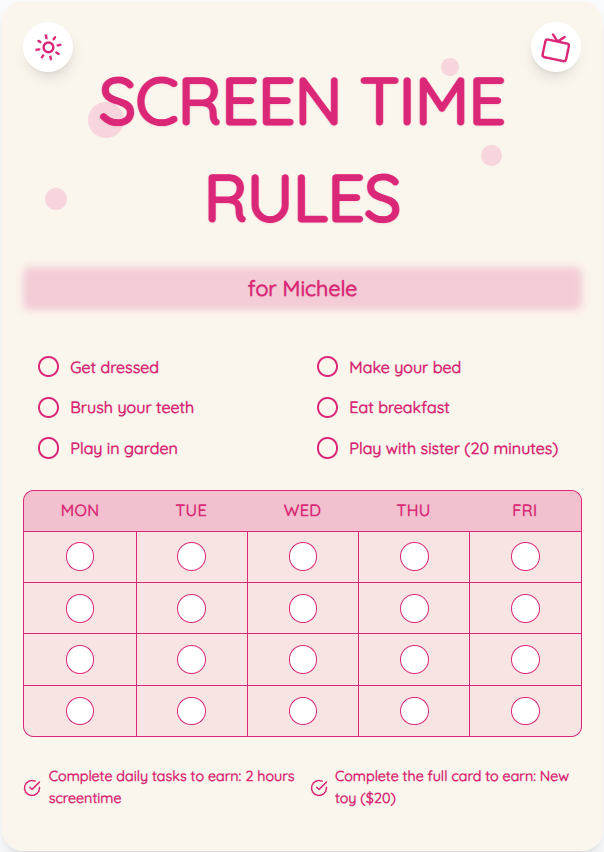Screen Time Downtime: A Parent's Guide to Balancing Tech Use for Kids
As a parent, navigating the digital landscape with your child can be challenging. Finding the right balance between screen time and downtime is crucial for their development. In this guide, we'll explore actionable strategies to help you manage screen time downtime effectively while fostering family harmony and promoting healthy habits for your children.
See What Your Screen Time Chart Will Look Like
Here's an example of a beautiful, customizable screen time rules chart you can create for your family

Understanding Screen Time Downtime
Screen time downtime refers to the periods when children are not engaged with screens, allowing them to rest, play, interact with others, or engage in offline activities. Balancing screen time with downtime is essential for promoting physical activity, social interactions, creativity, and overall well-being in children.
Practical Tips for Managing Screen Time Downtime
1. Create a screen time chart to establish clear limits and routines. 2. Encourage outdoor play and physical activities to counterbalance screen use. 3. Engage in screen-free activities like reading, arts and crafts, or board games. 4. Set a good example by modeling healthy screen habits yourself.
Put These Tips Into Action
Create a custom chart to implement these strategies with your child
Setting Boundaries and Consistency
Consistency is key when it comes to managing screen time downtime. Establish clear rules and boundaries around screen use and ensure that all caregivers are on the same page. Consistent routines help children understand expectations and develop healthy tech habits.
Promoting Family Engagement and Communication
Use screen time downtime as an opportunity to bond as a family. Schedule regular tech-free moments for quality time together, such as family dinners or weekend outings. Encourage open communication about screen time rules and listen to your child's perspective.
Practical Tips for Success
- Create a daily screen time schedule and stick to it.
- Encourage imaginative play and storytelling during screen-free hours.
- Discuss the importance of moderation and balance with your child.
- Use screen time charts from ScreenTimeRules.com for visual guidance.
Frequently Asked Questions
How much screen time is appropriate for children?
The American Academy of Pediatrics recommends limiting screen time to 1-2 hours per day for children aged 2-5 and ensuring that screen time does not interfere with sleep, physical activity, or other healthy behaviors.
What are the signs of excessive screen time?
Signs of excessive screen time include irritability, difficulty focusing, disrupted sleep patterns, and a lack of interest in non-screen activities. It's important to monitor your child's behavior and make adjustments as needed.
How can I encourage my child to take breaks from screens?
Set timers or use apps that remind your child to take breaks during screen time sessions. Encourage them to engage in short physical activities or creative pursuits between screen sessions to prevent prolonged sedentary behavior.
By implementing these practical tips and strategies, you can create a healthy balance between screen time and downtime for your child. Remember, moderation is key, and setting clear boundaries can help promote positive tech habits. Visit ScreenTimeRules.com to create personalized screen time charts that support your family's digital well-being.
Ready to Transform Your Family's Screen Time?
Join thousands of parents who have successfully managed screen time with our customizable charts.
